G.I.C.
A Weekly Outlook and Analysis of the
Global Investment Climate
26 June 2002
Printer Friendly Version
Focus Section
Will a seizure on Wall Street set back real
estate values?
Before we assess the answers to that question, we do not consider ourselves expert in the topic or sector, so I always hesitate in including it in our regular coverage.
We have, however, decided that there is some overlap to the extent that the real estate sector will suffer or not from a coming deflation, not to mention the significance that the sector has on the economy, or vice versa.
If anything, our expertise lies in the ability to read what the markets are telling us. Sort of like one would do at a poker table, except with a slightly different skill set.
The markets (charts and tape, not sentiment) are telling us today that the US dollar is overvalued for instance. Or, why else would they be in the process of lowering its value?
Of course, we view the value of the dollar not only in terms of the other fiat currencies it trades against on the CME, or over the counter, but also relative to the commodities it is exchanged for. Borrowing a well-known quote from a bumper sticker (so of course it must be true), "if it can't be grown it has to be mined," thus it also has to be bought.
Obviously, speaking inside of the box, when inflation is perceptible most investors are likely to question the value of the currency even within a closed economy, and without the existence of fiat exchange. After all, they're not that dumb. Speaking outside the box we know, however, that the inflation is already there. The symptoms of too much money abound. As policymakers lose control of this process, which they try to sustain, the symptoms ought to become more perceptible as they increasingly manifest in key commodities, whose fundamentals are typically out of whack by then.
Usually, during the monetary booms over the past century, the inflation tended to induce an overproduction of financial assets and related products, while lower relative commodity values meant less investment in the sector, perhaps, than was necessary in light of the high consumption of raw material goods with inflated and abundant currency.
Such dislocations tend to produce what we call shortages eventually, but particularly when the value of the currency can no longer be sustained artificially.
Any surge in demand arising from a revaluation of commodities with respect to the currency should encourage investment in infrastructure, but it takes time to adjust to the higher relative demand. If this seems inefficient, it is, but that's largely because this kind of secular demand is difficult to predict in the first place.
I think we can't underestimate the meaning of that paragraph. I believe we have to acknowledge that a collapse in commodity values is a boon to the owners of paper wealth, but also recognize that there could be other reasons for movements in these markets than those arising from typical or cyclical demand.
Consider, for instance, whether the collapse in gold prices during 1997 helped to sustain the inflation of paper assets by sustaining the value of the dollar? For the purpose of this point, it doesn't matter if the event is caused deliberately or not. What matters is whether the market agrees with a particular valuation. For in this case, the lower price of gold stoked demand, depleted supplies, encouraged malinvestment in dollar assets (which will encourage further a future demand for gold), and discouraged new investment in infrastructure. All things that are bullish in the long run.
And not just mining infrastructure. The markets and networks that have traditionally provided exploration capital have vanished.
If such valuations are deliberated, the longer they are sustained, the more vicious is the retribution likely to be. But when it comes, their effects make perceptible that which the government has worked so hard to hide. That's the monetary relationship between the dollar and commodities, but best seen in gold.
One can only fudge the data so far. I'm speaking of government price indexes, and their ill-conceived or misappropriated common uses.
Today we have the issue of credit to consider because of the size of debt burden that has amassed as a consequence of the long running inflation.
I don't mean to advertise but AFLAC has a good commercial running. At the end of it one gentleman (Yogi Berra) says to the other, cash is almost as good as money (paraphrase). The other man looked perplexed. Perfect. What a coup. Millions of people must have seen the commercial but almost none of them understand the truth behind that statement I can assure you.
The dollar isn't money. It's a money substitute. The cash component of the money supply data is considered M1. But the piece of paper currency it represents is itself a money substitute at its best. It's of different standing and has different character than the other currency included under M2, M3, or M7. However, it is similar in that they are all money substitutes in the end.
The quantity of credit outstanding can be considered excessive, easily. But what the heck does that mean for the value of the dollar when nobody wants dollars? It could be an important cyclical monitor for the value of the dollar. But should the bubble in credit implode, something it does only secularly, the question is "what is money?"
Large creditors are only going to want dollars for their credit to the extent the dollar is worth something to them. If it's value changes against commodities as well as the other fiat, our read of the market is that it is worth increasingly less. Are creditors calling in their loans going to hoard dollar bills in their safe if the credit bubble should collapse? Would they be better off hoarding bullion, or other potentially scarce hard money such as commodities or real estate?
What would you do as a creditor of the average corporation, or even the government should the economy, which supports the value of the international reserve currency, suffer a credit crisis? Would you trust the value of the currency? Would you believe that holding a piece of paper called cash, rather than a piece of paper exchangeable for it, will guarantee your wealth? What guarantee would you have that this piece of paper called cash will remain scarcer than say bullion? If your debtors can't pay for their real estate, and you take it from them, would you liquidate it for dollars? Why, so that they can be stuffed under the mattress? The Fed can't create land. There is only so much of the stuff to go around. It can build houses and tall buildings though. Especially those occupied by unviable businesses.
In this report, I'm not going to distinguish between commercial and residential real estate because we're going to focus on the big picture. Moreover, I'm not learned on the demographic developments driving the micro trends. However, I will say that it seems to me that the future for commercial real estate is more dire than that of the residential sector. In addition to the obvious arguments I could quote, people will always need a place to live, but today, with the help of technology, the tall office buildings and traffic the average commuter has to contend with to get to them each day may be outmoded. I'm not saying that we will all shut ourselves off in a den in suburbia like I do, but our technological capacity approaches that point where it is possible. Maybe entire working communities develop, I do not know. I only mean to illustrate the point that there are technological solutions to our big city problems that the market may sort out in due time. And however it does so, I don't think the commercial sector is prepared.
Stock Crash Could Cause Correction
We can't always be right, but we'll try. We've discussed the question
of real estate before - in the spring of 2001 - and concluded at the time
that none other than the Federal Reserve was putting the pieces together
to ignite a real estate bubble as the remedy for a deflating paper bubble
(Nominal Net Worth).
Since then, while the major US averages continued to fall, the Dow Jones REIT index has advanced along with gold, and the commodity sectors. Prices for new homes grew at a 10% rate in 2001. Existing home sales prices grew at a more moderate 5 percent pace last year.
The S&P homebuilders have been on a tear, gaining 40% or so over the past year. Of course, this pales in comparison to gains made in the gold sector in the same period.
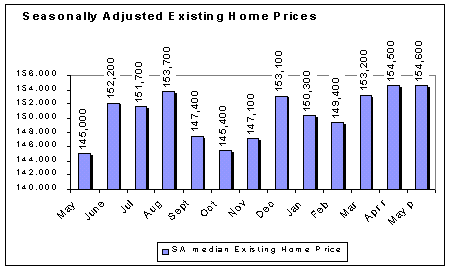
In May 2002, the National Association of Realtors just reported that the median existing home sold for 6.6% more when compared with last year's prices, seasonally adjusted, and 8.9% when not seasonally adjusted. And although sales were reported to have contracted by 0.3% compared with April they were up by 6.5% in a year over year comparison, and seasonally adjusted. The data are also preliminary estimates from the NAR.
But all this good news comes after the sector grew at below average long-term rates for most of the nineties. From 1990 - 1995 we found that the average new US home price grew at an average 2 percent per year. From 1995 to 1999 this rate of growth improved to about 7% (6 percent is the unweighted average since 1975).
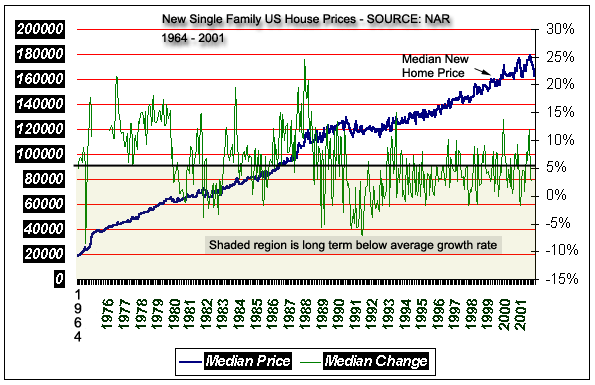
All price references are nominal and not adjusted for CPI or otherwise, unless stated.
Only since the year 2000 have house prices grown at the recently heated pace.
The real estate sector tends to be a counter force, as does the gold sector, rising in a bear market and falling in a bull market. The REITS and homebuilders fell sharply in 1999, for instance.
From the data in the chart below we calculate a negative correlation coefficient of 33 percent (negative) between the returns on the two asset classes, indicating that the two assets have quite often moved in opposite directions over the past thirty years.
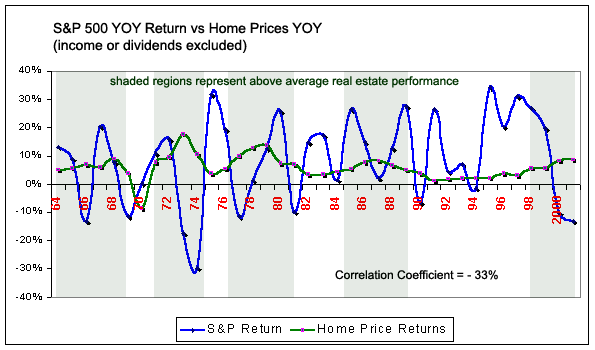
Interestingly, the price data is at least as sensitive to stock bubbles as stock meltdowns historically, at least in terms of consistency. The 1966 decline in stock prices was a little more severe than the one that occurred in 1969, but house prices fell with the latter less severe decline in 1969, into 1970.
The next time they were going to peak (from much higher levels) was late 1973, when stock prices were about to fall at their fastest pace in years, forward or back.
But remember, peaking in terms of growth rates is different than peaking in terms of value. The point is that the most severe crunch in stock prices the world had seen in years only slowed down the gain in real estate values for a year or two.
Moreover, that slowdown in growth was still a faster pace of gain than the US market has seen to this day, or at least since the late eighties.
From the data in the chart above we can count five instances out of ten where the deflation of equity values may have catalyzed a correction in real estate values. But then there are also five instances where the market continued to bid up real estate values regardless of the fall in stock prices. The ownership of both stocks and real estate by individuals is nevertheless at historic highs. That needs to be factored to understand the impact of a stock market crash on the consumer's balance sheet as well as his or her resultant behavior with respect to any real estate holdings.
What also needs to be factored, I think, is the extent to which mortgages can't be converted from adjustable to fixed before interest rates go up, something the academics don't see at the moment because they all expect stock and economic weakness to support the value of the dollar, thus presumably cap interest rates. Yet here too the historical precedent is revealing. Mortgage rates and bond yields rose from the late fifties and continued to rise until they peaked in 1982. Yields had doubled in the sixties, doubled again in the seventies, and then almost doubled again in only the first two years of the eighties. But since the fifties, the best gains in real estate prices came during the seventies, the last period where the Fed had trouble in controlling the inflation.
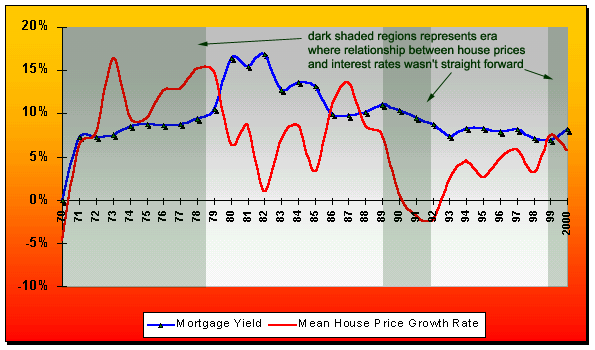
We have some good friends in the (real estate) development business in Vancouver. As a consequence, our views on interest rates & inflation are often solicited. I won't reveal identities here, but the reason I've brought it up is because I am reminded of a conversation with one of them last year during one of our typical idea exchanges.
Billy (alias) was ready to cash in his company's chips, sell all of their real estate, and take a long sabbatical in search of another business to invest in. Of course, anyone who could write like I do can promote, but we all know that's not what I do.
Nonetheless, buy the time our conversation ended Billy said, "I love inflation!"
Instead of his vacation their company went to work and bought a whack of dirt for development. Since then they've made a good deal of money.
Of course, when he said, "I love inflation," he was probably unaware that one day this really meant he and his company would own too much real estate.
I'm working on making them aware of it.
The point is that the real estate bubble is on for now and I'm not sure it will end any time soon, with the caveat that depends on the prognosis for further deterioration in the financial sectors. In other words, I'm confident that real estate values can gain even in a bear market for stocks so long as the bear market isn't a crash. But since our outlook includes the possibility of a crash in stock values we should acknowledge the ramifications of a resultant potential credit crunch on real estate values. We do.
But we are choosing to argue this topic from the perspective we might glean by also acknowledging that such a credit crunch would put the dollar's value and liquidity in question. As a consequence, regardless of what happens over the next year, we see real estate as one of the better performing asset classes over the next ten years, and expect to see land values in the US, and maybe the world, repeat the double digit performance made in the seventies. Though that conclusion does not preclude a decline in the interim. Nonetheless, this is where our arguments differ sharply from analysts that perceive a deflationary outcome when the credit bubble pops. It is why we see the inflation breakdown as a precursor to price spirals similar to the seventies, but this time I think worse. Most reporters and analysts will call it stagflation, but that's a misleading term. The fact is that there are at least two markets operating in any transaction.
The market that determines the value of the real estate relative to other assets, and the one choosing the best money (or money substitutes) to exchange for it.
At any rate, even with that scenario in mind, the question remains, what will happen to real estate values if the stock and credit bubble seized up tomorrow?
We'll go along with the idea that they'll suffer a correction. However, I must stress it isn't exactly a probability. The historical record suggests it is only possible. And if it does occur, even if its extent is vicious, I'd be surprised to see it last longer than a year if we're correct about the fate of the dollar, and regardless of a rise in interest rates.
Any asset or commodity that has suffered from overproduction in the past cycle is likely to decline on a significant contraction in the paper wealth of the economy. However, in the end, we believe the dollar is going to suffer the most as the upshot of the after affects of the New Economy extravaganza the Fed gambled our monetary system on.
Housing Starts Lead Prices
House prices fell in 1970. According to the NAR, the mean price of a new
home in 1970 fell by 4.66%. The median price of a new home fell more.
From 1969 to 1972 the real estate market was not the place to be. The
stock market started to become a dangerous place for investors as well.
But the worst was yet to come for the stock bulls in the 1973-74 rout
that saw the Dow fall by about 40%, as mentioned earlier.
By 1970 US housing starts grew a little more than 8%, after falling since 1966. The uptick could have contributed to the fall in house prices that year. But in 1971 starts grew by another 35%, followed by a more reasonable 9% in 1972.
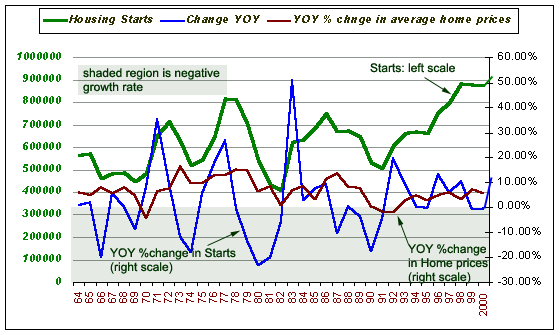
What do you think happened then? One might think that the 70-72 surge in housing starts meant a glut. By all accounts it probably looked like one, particularly in such a miserable market. But by 1971, house prices recovered the prior year's losses, and by 1973, the mean US home price grew by 16.4%, which is still a record to this day.
The 1972 spike in housing starts was the fastest pace of growth this data was going to see until 1983, when housing starts in the US surged a more remarkable 50%.
From 1973 to 1979 the average US home price grew from 10 to 16 percent each and every year, almost twice the pace of gains in prior decades. This is why the housing starts data is a leading indicator. Housing starts fell from 1972 to 1974, also leading the market since house prices moderated their growth spurt between 1974 and 1975 relative to what they were growing at in prior and subsequent years. They only grew by 10% in each of those two years. The next bear market for house prices was going to start in 1980 and continue until 1983. Prices still grew in those years, on average, but moderated their gains to 1% by 1982. Housing starts fell year in and year out during that time as interest rates spiked to 18%, which made it uneconomic to build. In 1983 as interest rates settled down, however, housing starts in the US soared by 51%.
The price of a new home was going to grow by 7% that year, and in the course of the bull market was going to peak at almost a 14% rate of growth by 1987, four years later.
Housing starts fell between 1986 and 1991, fulfilling their leading indicator role once again, as the US was about to embark on six-year real estate recession. In 1991 the US economy only produced 500,000 new homes. That was a sharp drop from a 750,000 annual rate in 1986. 1991 and 1992 were going to become the first 2 years that the mean US new home price would fall since 1970. By 1992 housing starts picked up again, rising by nearly 20% that year and again forecasting a recovery in the sector.
While the growth rate of house prices stayed below average throughout most of the nineties, the rate gradually increased in the years immediately after the surge in new home construction the prior year. After the 1993 spike in housing starts the economy produced more new homes each year, but at a moderate (though more consistent than usual) pace, perhaps a neutral pace from the perspective of forward-looking implications.
Real Estate or Dollars?
It seems the best explanation for the bubble in real estate values over
the seventies in light of rising unemployment, rising interest rates,
and falling stock market values, during that period, is dollar devaluation.
After seven years of double-digit gains in the average home value, the market likely suffered a good deal of overproduction. The spike in interest rates, and the collapse of the economy and commodity values on a recovery in the value of the dollar by the early eighties was enough to put an end to the bull market in all hard assets.
The real estate gains in the 1986/87 periods were made on soaring share values and falling dollar anew. The following eight years were going to see ongoing weakness in the dollar and rising prices. But that was no consolation to real estate values as they grew slower and slower until they finally fell in 1990. That said the dollar actually recovered some in 1988 and 1989, as did Wall Street, after the 1987 crash.
The picture isn't clear, but the dollar was weak in 1990 due to several factors, which included a weak consumer and banking system. It may have fallen as a reaction to the weakness in asset prices. From its nadir in 1990, the dollar traded sideways in a neutral but wide range until it broke out in 1997 (though the beginning of that rally occurred in 1995). The dollar peaked mid 2001, but against commodity values it peaked in 2000.
So it is a good sign for our hypothesis that the growth rates of real estate prices received a boost from some of that, and despite the sticky mortgage yield, falling stocks, and contracting economy. Still, the hypothesis isn't perfect, even if we point out that the dollar weakness in the eighties and early nineties was nothing like the devaluation in the seventies, and nothing like the one we foresee.
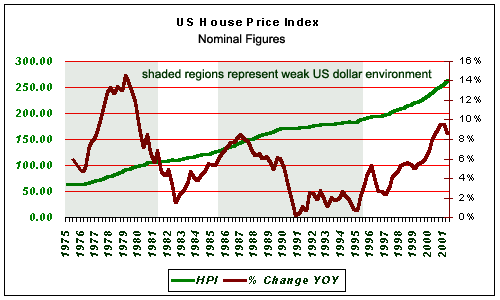
Until the day the economy decides on something other than the dollar as its most liquid medium of exchange - liquid doesn't mean plentiful, but rather, it applies to something that is always in demand - real estate values should continue to gain relative to the dollar's falling value.
The effects of the credit expansion cannot in my estimation be isolated to the asset it inflated. There is an effect on the value of the currency that the credit supports.
This is especially true when the credit cycle busts. But so long as lenders and borrowers are willing to enter into credit transactions with each other, the credit cycle can grow indefinitely. Why couldn't it? There is something that eventually stops it.
That is an overproduction of the asset or good or service to the point where lenders at least are not willing to lend into a market that is falling. For as long as the asset that is driving the credit cycle can appreciate in value it isn't likely that the borrower's appetite would settle, and it is possible that the asset gains could consistently reduce his or her burden of liability. That's how bubbles work, is it not?
There is a dynamic relationship between the target asset and the inflation of money and / or credit that it is inducing. As long as the asset(s) can rise in value, the credit can grow, and depending on foreign affairs, such a cycle could support the value of the currency, or so-called money even if unsustainably, until the day that its value comes into question. That's what we've learned this past cycle I believe.
The reason consumer credit is in trouble is that one of the factors the consumer has come to rely upon for increasing his or her purchasing power, wealth, and collateral, has been undermining those past benefits for the past two years - sinking stock prices.
Luckily for the consumer, one of the saving graces of the real estate gains to date for policymakers is they've allowed consumers to expand their balance sheets regardless of how bad they appear today.
Although, the refinancing activity has also spurred demand for adjustable rate deals at just the wrong time, I think, which could be a catalyst if and when rates rise.
Asset
Values Determine Credit Bubble Fate
Stock prices didn't turn down in 2000 because the bubble in credit burst.
The turn down in stock prices threatened to burst the credit bubble, or
at least poke it hard. Stock prices turned down on their own internals,
and continue to turn down due to the problems associated with, and created
by, excessive valuations caused by the unbridled growth of inflation and
government intervention.
So to say that the real estate bubble will burst because there is an overproduction of real estate is one thing but to say that it will burst because credit has been inflating in this sector since 1998 is moot. It's been inflating longer than that in fact.
The question is real estate values. The bullish factor for the industry is that the bust in the financial asset cycle has yet to fully reflect in the value of the dollar.
If the dollar fell by 30 percent for instance while commodity values and interest rates soared, could the insolvent homebuyer afford to pay his mortgage? He might if the value of his real estate gained enough that his banker accommodated him, or so long as his local union went after its share of the wealth transfer or monetary debasement so that his wages increased enough to cover the higher cost of living.
The question of what will happen to Fannie and Freddie and the other intermediaries is not something I want to tackle. Frankly, it's too difficult.
Their dissolution will have to remain a speculative wildcard that I'd put in the same league as the dissolution of the Fed. Both are possible, maybe even probable some day, but when and what would it mean for real estate values? I would hesitate to make the tempting conclusion that real estate values should fall. For both of those institutions play a key role in underpinning the value of the dollar today.
Moreover, any hint of a failure of one of these institutions is likely to put the Fed into action so that the inflation is only aggravated.
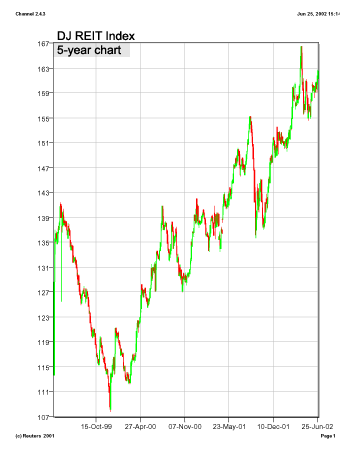 The
valuation of the REIT sector would be an important consideration in determining
the outcome of a real estate bubble. Unfortunately, I hesitate in tackling
that sector of the market as well, though here only for a lack of time.
Generally, the sector has performed as well as the gold shares have, and
has been a little more resilient in the face of the broad market decline
than gold shares have. Though they haven't gained as much as gold shares
have over the past 12 months.
The
valuation of the REIT sector would be an important consideration in determining
the outcome of a real estate bubble. Unfortunately, I hesitate in tackling
that sector of the market as well, though here only for a lack of time.
Generally, the sector has performed as well as the gold shares have, and
has been a little more resilient in the face of the broad market decline
than gold shares have. Though they haven't gained as much as gold shares
have over the past 12 months.
However, if the investment trusts were to decline in value as a result of a general stock market rout I could see how real estate values would fall despite the weaker dollar, at least to the extent the falling REIT values persuade wholesale underlying asset liquidations. But I haven't thought that out enough to say whether it's a reasonable or simply bearish conclusion.
The key to the mortgage bubble in my opinion is what happens to real estate values first, not when the expansion in mortgage credit will cease to provide impetus. The key to the question of real estate values I believe lies in determining what happens to the value of the dollar, and whether everyone has calculated the impact of a falling dollar on other assets, wages, interest rates, commodity prices, employment, and savings rates or trends.
All of these things will look different under dollar stress. We believe they will look much like they did in the seventies.
Bullish analysts (on the dollar) will say today that interest rates won't rise. They say that right at the same time that they say stock prices relative to interest rates have rarely been cheaper. Now if we could only get them to use trailing earnings... The point is that all of their models assume these macro variables are static. People's brains work much the same. Our outlook almost always is an extension of the most recent past, unless we're trained otherwise I presume. Several well regarded analysts argue for a deflation outcome. Their guage is the long running bear market in commodities, the coming collapse in stock prices, and normally, an unreasoned outlook for the value of the dollar, its impact on other things, as well as an improper definition of the term inflation.
If the value of the dollar is determined by various factors, and some of them begin to erode, it's commercial value in global trade is going to be affected. We just can't know by how much and what else may offset it. If it loses its appeal as the most preferred (or liquid) medium of exchange in global affairs the market is likely to devalue it in terms of certain exchanges. To the extent that financial asset values have boosted the dollar in the recent cycle, their continued weakness could impair its standing relative to other currencies and commodities, and even culminate in a credit crunch.
But whether that crunch includes the real estate sector should depend on what happens to land values, wouldn't you think? Who cares if someone owes money on that land, if I think it is going to appreciate it would make sense for me to pay his debt and buy the house from him. Thus, declining stock valuations threaten two things: to undermine the value of the dollar, but also, they threaten to pierce a credit bubble. The answer to the real estate puzzle I believe laregely resides in the answer to the question of how a bursting credit bubble would interact with the value of the dollar. I strongly disagree that it is as simple as saying that a contracting credit cycle would force everyone to hoard dollars and thus result in deflation. One can't come to such a conclusion without an understanding of the process that determines the economy's money. No, it isn't the government. They only create currency and "enhance" its value.
This (land) inflation isn't likely to bust until the overproduction and valuation of the housing sectors are distorted such that values cannot rise any longer regardless that lenders' eagerness remains strong. I do believe this is one of the goals of current policy. Extreme circumstances probably call for extreme measures if their MO is an indication.
The Fed's Inflation Trap
Take the stock market for instance. The layperson is convinced that the
gold bull will collapse once the Fed raises interest rates. But the Fed
is trapped. If it raises rates it would cause stock market turbulence
because the main problem for equities is the valuation issue. Moreover,
the dollar hasn't fallen yet. It is only telegraphing that at the moment.
If the Fed raises interest rates and the twin bubbles (dollar and stock
market) continue to fall, how would that undermine the gold bull?
Maybe the dollar wouldn't fall if the Fed raised rates? That hopeful argument usually emanates from deflation biased analysts that cannot fathom the relationship between the US current account deficit, the dollar, and US financial assets as it has been through the course of history.
Still, it's conceivable that a monetary bust needn't turn into a credit cycle bust so long as the assets that drive the credit cycle continue to gain in value enabling the credit cycle to grow. That said it is possible a credit cycle bust can engender a monetary bust. In such a circumstance, we need to consider the affects on the value of the currency as well as what part of the economic structure the devaluation may stimulate demand in.
Why can't our fellow analysts see that? Is our case so unreasonable? I don't think so but maybe that's what makes us contrarian today.
Perhaps there are pockets of overproduction in the housing sector, but by and large, the quantity of real estate on any continent is fixed. This is the ace in the hole that keeps us cautiously bullish on real estate values in the long run, or at least as long as the bust in financial assets continues to manifest in the value of the currency: the dollar, and especially relative to commodity values, if we're to guage potential monetary gains in land values.
Fed's Vested Interests
To avoid devaluation in the dollar, the Fed is charged with supporting
equity market valuations at least until it is confident that increasing
interest rates would not impact the dollar negatively, we presume. This
means the Fed and its crony bankers have to get a real estate boom going,
which is precisely what is underway.
Yes, it's another government program.
Major incentives are underway by the government to widen the home buying market to minorities as well as the typically poor strata of society.
Greenspan himself has suggested at least a few ways in which communities can organize themselves around such an agenda. Since the Fed's Humphrey Hawkins mandate expired in 1999 it has been busy lobbying for a larger presence in the mortgage business, seeking approval for expanding its open market operations to include mortgage backed securities, and altering pieces of legislation here and there that might allow its banks more room to maneuver or grow in the real estate industry.
Some of those incentives quieted down, but new ones have been announced by the President. The Fed's budget surplus forecasts fell by the wayside (the argument that was being used to justify a greater mandate in their open market operations was that the budget surplus would make Treasury bonds obsolete one day).
There is no question in my mind the Fed, government, and their banking allies are fully behind this boom in real estate values. It's the only asset class that is still in a bull market, and it's the asset that has best endured the monetary busts during the 20th century, particularly after 1933 (we don't refer to gold as an asset, it's money, in terms of its economic role anyway). Real estate is shown to be the one asset that "consistently" benefits from any kind of inflation. Not that it doesn't have setbacks.
It does, but they rarely have lasted longer than a year or two in the past.
Still, this time may be different. The Fed's utopian hope is that real estate values turn into the next best play on the US dollar, while the stock market dies a quiet death. But real estate values can only really gain in a weak economy if the dollar falls in value.
Nevertheless, unlike gold, which is not an encouraged store of monetary wealth, real estate is. As a consequence, it is probably more susceptible to overproduction, or in other words, malinvestment. Should the stock market and dollar collapse, as we do anticipate, while the banking community is still long other equities as well as short bullion, a crunch in credit could ensue that hinders the lender's willingness or ability to lend to the eager borrower. But so long as real estate values can rise on a drop in the dollar's value, it seems reasonable to expect both the Fed and the banking community will continue to find reason in the madness. After all, they're short bullion not real estate (yet). We don't want to repeat the common analytical error of calling a top too early in the tech bubble a year or two before it actually was a top.
To avoid that I think we have to stay away from looking at every inflation as immediately unsustainable and move towards understanding how the inflation is likely to manifest in participant's relative valuation judgments. In order to do that we have to expand our meaning of inflation beyond an expansion of credit. We have to apply it to money separately, while still acknowledging the connection between money and credit.
I think we have to realize that inflation is something, which ultimately manifests in the debasement of the currency that is its initial "confidence target."
In this kind of economy, the idea is to sustain the inflation (applying the definition only to money and credit). That is our economic order today. To the extent this means promoting the value of real estate, the credit expansion can continue so long as the market favors the Fed's policies, or is persuaded by them.
And it seems reasonable to conclude that it can probably continue so long as the value of real estate is increasingly higher than the paper it is exchanged for. Of the developed countries, UK real estate values are up the most since 1998. The period is marked by weakness in the pound and recently, by weakness in share values also.
The relationship between money and real estate values is probably nowhere better seen than where the quantity of land is as fixed as it is on an island about 1% the size of North America's land mass.
If the creditworthiness of the debtors supporting the currency can determine the value of a currency everywhere else in the world, why couldn't it determine the value of the US dollar too? Contracting credit doesn't necessarily mean contracting money if the market is in the process of determining a better money altogether.
Gold is better money, and we continue to hold that it is only in terms of the price of gold the US will see any deflation in its economy. While almost everyone disagrees with the strength of our conclusion, nobody has cogently shown us why the dollar is not going to fall faster than the price of a commodity or hard asset, if you will.
Good luck,
Edmond J. Bugos
The GoldenBar Global Investment Climate is not a registered advisory service and does not give investment advice. Our comments are an expression of opinion only and should not be construed in any manner whatsoever as recommendations to buy or sell a stock, option, future, bond, commodity or any other financial instrument at any time. While we believe our statements to be true, they always depend on the reliability of our own credible sources. Of course, we recommend that you consult with a qualified investment advisor, one licensed by appropriate regulatory agencies in your legal jurisdiction, before making any investment decisions, and barring that, we encourage you to confirm the facts on your own before making important investment commitments.